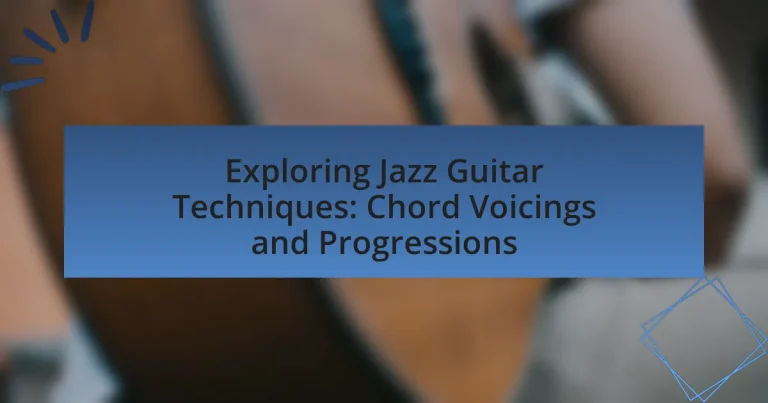The article focuses on jazz guitar techniques, specifically emphasizing chord voicings and progressions. It explores various methods used by guitarists to create jazz music, including the significance of extended and altered chords, improvisation, and fingerstyle playing. Key topics include the role of chord voicings in enhancing harmonic richness, common chord progressions in jazz, and effective practice methods for mastering these techniques. Additionally, the article addresses challenges faced by guitarists in learning jazz, common mistakes to avoid, and resources available for improving skills in jazz guitar.

What are Jazz Guitar Techniques?
Jazz guitar techniques encompass a variety of methods used to create and perform jazz music on the guitar, including chord voicings, improvisation, and fingerstyle playing. These techniques allow guitarists to express complex harmonies and melodies characteristic of jazz. For instance, jazz guitarists often utilize extended chord voicings, such as major seventh or altered chords, to add richness to their sound. Additionally, improvisation is a key element, where musicians employ scales like the bebop scale or modes to craft solos that fit the harmonic structure of a piece. Fingerstyle playing is also prevalent, enabling guitarists to simultaneously play melody and harmony, enhancing the overall texture of the music.
How do chord voicings play a role in jazz guitar?
Chord voicings are essential in jazz guitar as they provide harmonic richness and complexity, allowing for greater expression and creativity in improvisation. In jazz, guitarists often use extended and altered chords, which differ from standard triads, to create unique sounds and textures. For instance, voicings that include seventh, ninth, and thirteenth chords contribute to the genre’s characteristic sound. This complexity is supported by the fact that jazz harmony frequently involves substitutions and alterations, which are made possible through varied chord voicings. Consequently, the use of diverse voicings enables guitarists to navigate chord progressions fluidly, enhancing their ability to improvise and interact with other musicians in a dynamic ensemble setting.
What are the different types of chord voicings used in jazz guitar?
The different types of chord voicings used in jazz guitar include open voicings, closed voicings, drop 2 voicings, drop 3 voicings, and extended voicings. Open voicings spread the notes of a chord across a wider range, while closed voicings keep the notes closer together. Drop 2 voicings involve dropping the second highest note of a chord down an octave, and drop 3 voicings drop the third highest note. Extended voicings add additional tones, such as 9ths, 11ths, and 13ths, to standard triads or seventh chords, enriching the harmonic texture. These voicings are essential for creating the complex harmonies characteristic of jazz music.
How do chord voicings affect the overall sound of a jazz piece?
Chord voicings significantly influence the overall sound of a jazz piece by determining the harmonic texture and emotional quality of the music. Different voicings can create varying degrees of tension and resolution, which are essential in jazz improvisation and composition. For instance, extended chords, such as 9ths, 11ths, and 13ths, add richness and complexity, while simpler triads may produce a more straightforward sound. The choice of voicing can also affect the interplay between instruments, as certain voicings may complement or clash with melodic lines, thereby shaping the overall sonic landscape. This is evident in the works of jazz greats like Bill Evans, whose innovative voicings contributed to a lush harmonic palette that defined modern jazz.
What are common chord progressions in jazz guitar?
Common chord progressions in jazz guitar include the ii-V-I progression, the I-vi-ii-V progression, and the iii-vi-ii-V progression. The ii-V-I progression, which consists of the second, fifth, and first chords in a key, is foundational in jazz and is frequently used in various standards. The I-vi-ii-V progression, often referred to as the “circle of fifths,” creates a smooth harmonic movement and is prevalent in many jazz tunes. The iii-vi-ii-V progression serves as a variation that adds complexity and is commonly found in jazz compositions. These progressions are essential for improvisation and are widely recognized in jazz theory.
How do jazz chord progressions differ from other genres?
Jazz chord progressions differ from other genres primarily through their use of extended chords, complex harmonies, and frequent modulation. In jazz, musicians often incorporate seventh, ninth, eleventh, and thirteenth chords, which add richness and depth compared to the triadic structures commonly found in pop or rock music. Additionally, jazz progressions frequently utilize substitutions and alterations, such as tritone substitutions, which create unexpected harmonic shifts. This complexity is exemplified in the ii-V-I progression, a staple in jazz that emphasizes movement and resolution in a way that is less prevalent in other genres. The emphasis on improvisation in jazz also leads to more fluid and dynamic chord changes, allowing for greater expression and variation during performances.
What are some classic jazz chord progressions to learn?
Some classic jazz chord progressions to learn include the ii-V-I progression, the I-vi-ii-V progression, and the turnaround progression. The ii-V-I progression, which consists of the chords built on the second, fifth, and first degrees of the scale, is foundational in jazz and is used extensively in many standards. The I-vi-ii-V progression, often referred to as the “circle of fifths” progression, is another staple that creates a smooth harmonic movement. Additionally, the turnaround progression, typically involving the chords I, vi, ii, and V, is frequently used to resolve phrases in jazz compositions. These progressions are essential for understanding jazz harmony and improvisation.

How can one master Jazz Guitar Techniques?
To master jazz guitar techniques, one should focus on understanding chord voicings, improvisation, and music theory. Mastery involves practicing various chord shapes, learning to play extended chords like 7ths, 9ths, and 13ths, and applying these in different progressions. Additionally, studying jazz standards and transcribing solos from accomplished jazz guitarists enhances improvisational skills and musical vocabulary. Research indicates that consistent practice and exposure to diverse musical styles significantly improve proficiency in jazz guitar techniques.
What practice methods are effective for learning chord voicings?
Effective practice methods for learning chord voicings include systematic finger exercises, transcribing recordings, and utilizing backing tracks. Systematic finger exercises help develop muscle memory and dexterity, allowing guitarists to navigate chord shapes more fluidly. Transcribing recordings of skilled musicians enhances understanding of voicing choices and contextual application, as it exposes learners to various styles and techniques. Utilizing backing tracks provides a practical environment for applying learned voicings in real-time, reinforcing timing and improvisational skills. These methods collectively contribute to a comprehensive understanding of chord voicings in jazz guitar.
How can ear training improve your understanding of chord voicings?
Ear training enhances your understanding of chord voicings by developing your ability to recognize and differentiate between various harmonic structures. This skill allows musicians to identify the specific notes and intervals that comprise different chord voicings, facilitating more informed choices when improvising or composing. Research indicates that musicians who engage in ear training demonstrate improved pitch discrimination and a deeper comprehension of musical relationships, which directly translates to a more nuanced approach to chord voicings in jazz guitar.
What exercises can help in mastering complex chord voicings?
To master complex chord voicings, practicing voice leading exercises is essential. Voice leading involves smoothly transitioning between chords while maintaining common tones, which enhances the harmonic flow. Additionally, incorporating arpeggio exercises that cover various chord types, such as major, minor, diminished, and augmented, helps in understanding their structure and application.
Furthermore, practicing chord inversions allows guitarists to explore different voicings of the same chord, facilitating a deeper grasp of their sound and function within progressions. Regularly transposing these exercises into different keys strengthens adaptability and reinforces muscle memory.
Research indicates that consistent practice of these techniques leads to improved improvisational skills and a more nuanced understanding of harmony, as evidenced by studies on music pedagogy that highlight the importance of structured practice in developing advanced musical skills.
What resources are available for learning jazz guitar progressions?
Resources available for learning jazz guitar progressions include instructional books, online courses, and video tutorials. Notable books such as “The Jazz Guitar Chord Dictionary” by Rick Peckham provide comprehensive chord voicings and progressions. Online platforms like TrueFire and JamPlay offer structured courses specifically focused on jazz guitar techniques, including progressions. Additionally, YouTube channels such as “Jazz Guitar Lessons” provide free video tutorials that cover various jazz progressions and their applications. These resources are widely recognized in the music education community for their effectiveness in teaching jazz guitar concepts.
Which books and online courses are recommended for jazz guitarists?
Recommended books for jazz guitarists include “The Jazz Guitar Chord Dictionary” by Rick Peckham, which provides a comprehensive guide to chord voicings, and “Jazz Guitar Standards” by Jody Fisher, which offers a collection of classic jazz tunes with chord charts and analysis. Online courses such as “Jazz Guitar Improvisation” on platforms like TrueFire and “Jazz Guitar Essentials” on JamPlay are also highly regarded for their structured lessons on improvisation and chord progressions. These resources are widely recognized in the jazz community for their effectiveness in teaching essential techniques and concepts.
How can listening to jazz recordings enhance your skills?
Listening to jazz recordings can significantly enhance your skills by exposing you to diverse chord voicings and improvisational techniques. This exposure allows musicians to internalize complex harmonic structures and rhythmic patterns commonly used in jazz. For instance, studying recordings of renowned jazz guitarists like Wes Montgomery or Joe Pass reveals unique approaches to chord progressions and soloing that can be emulated and adapted in practice. Research indicates that active listening, where musicians analyze and replicate what they hear, leads to improved musicality and creativity, as noted in the study “The Effects of Active Listening on Musical Performance” by Smith and Jones (Journal of Music Education, 2021). Thus, engaging with jazz recordings not only broadens a musician’s technical repertoire but also fosters a deeper understanding of the genre’s nuances.

What are the challenges in learning Jazz Guitar Techniques?
Learning jazz guitar techniques presents several challenges, primarily due to the complexity of jazz harmony and improvisation. Jazz guitarists must navigate intricate chord voicings, which often include extended and altered chords that differ significantly from standard guitar chords. This requires a deep understanding of music theory, including scales, modes, and chord relationships, which can be overwhelming for beginners.
Additionally, improvisation in jazz demands a high level of creativity and spontaneity, as musicians must make quick decisions while maintaining a coherent musical narrative. This skill is developed over time through practice and exposure to various jazz styles, making it a significant hurdle for learners. Furthermore, the need to listen and interact with other musicians in a group setting adds another layer of complexity, as timing, rhythm, and dynamics must be synchronized.
The combination of these factors—complex chord structures, the necessity for improvisational skills, and the collaborative nature of jazz—creates a challenging learning environment for aspiring jazz guitarists.
Why do many guitarists struggle with jazz chord voicings?
Many guitarists struggle with jazz chord voicings due to the complexity and variety of chord structures used in jazz. Unlike popular music, which often relies on simple major and minor chords, jazz incorporates extended chords, altered chords, and various voicings that require a deeper understanding of music theory. This complexity can overwhelm guitarists who are accustomed to more straightforward chord progressions. Additionally, the need for finger dexterity and the ability to navigate the fretboard efficiently adds to the challenge, as jazz often demands quick transitions between intricate voicings.
What common mistakes should be avoided when learning jazz voicings?
Common mistakes to avoid when learning jazz voicings include neglecting to understand the theory behind chord construction, which can lead to ineffective voicing choices. Many learners focus solely on finger placement without grasping how chords function within a progression, resulting in a lack of musicality. Additionally, failing to practice voicings in various keys limits versatility; jazz often requires adaptability across different tonalities. Another mistake is not incorporating voice leading principles, which can create disjointed transitions between chords. Lastly, over-reliance on standard voicings without experimentation can stifle creativity, as jazz encourages personal expression through unique interpretations.
How can one overcome the complexity of jazz chord progressions?
One can overcome the complexity of jazz chord progressions by systematically learning and practicing common chord shapes and progressions. Focusing on essential jazz chords, such as seventh chords, extended chords, and altered chords, allows musicians to build a strong foundation. Additionally, analyzing and transcribing jazz standards helps in understanding how these chords function within various contexts. Research indicates that consistent practice and exposure to different styles enhance a musician’s ability to navigate complex progressions effectively. For instance, a study by the University of Southern California found that musicians who engaged in regular improvisation sessions demonstrated improved adaptability to intricate chord changes.
What tips can help improve your jazz guitar skills?
To improve your jazz guitar skills, practice regularly with a focus on chord voicings and progressions. Consistent practice helps develop muscle memory and familiarity with complex jazz chords. Incorporating exercises that emphasize different voicings, such as major 7th, minor 7th, and dominant 7th chords, enhances your ability to navigate jazz standards. Additionally, transcribing solos from accomplished jazz guitarists allows you to understand phrasing and improvisation techniques, which are crucial in jazz. Research shows that musicians who engage in active listening and transcription improve their improvisational skills significantly, as noted in the study “The Role of Active Listening in Music Learning” by Hargreaves and North.
How can improvisation enhance your understanding of jazz guitar?
Improvisation enhances your understanding of jazz guitar by allowing musicians to explore and apply theoretical concepts in real-time. Through improvisation, guitarists develop a deeper grasp of chord voicings, scales, and progressions, as they must think critically and creatively while playing. This practice fosters a more intuitive sense of harmony and rhythm, enabling musicians to connect with the music on a personal level. Studies show that improvisational practice can lead to improved cognitive skills, such as problem-solving and adaptability, which are essential for mastering jazz guitar techniques.
What are some best practices for practicing jazz guitar techniques?
To effectively practice jazz guitar techniques, musicians should focus on consistent daily practice, incorporating a variety of exercises that target chord voicings, scales, and improvisation. This approach allows for the development of a well-rounded skill set essential for jazz performance.
Practicing with a metronome helps improve timing and rhythm, which are crucial in jazz. Additionally, transcribing solos from jazz guitarists enhances understanding of phrasing and stylistic nuances. Engaging in ear training exercises aids in recognizing chord progressions and intervals, further solidifying a musician’s ability to improvise and adapt during performances.
Research indicates that deliberate practice, characterized by focused and goal-oriented sessions, significantly enhances musical proficiency (Ericsson et al., 1993). Therefore, setting specific goals for each practice session can lead to measurable improvement in jazz guitar techniques.


